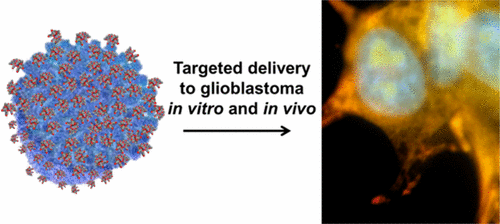当前位置:
X-MOL 学术
›
ACS Chem. Neurosci.
›
论文详情
Our official English website, www.x-mol.net, welcomes your
feedback! (Note: you will need to create a separate account there.)
Transfer of Dyes and Drugs into Cells Using EGFR-Targeted Nanosyringes
ACS Chemical Neuroscience ( IF 4.1 ) Pub Date : 2017-08-14 00:00:00 , DOI: 10.1021/acschemneuro.7b00138 Lizanne G. Nilewski , Melissa Singh 1 , David S. Baskin 2 , James M. Tour , Martyn A. Sharpe 2
ACS Chemical Neuroscience ( IF 4.1 ) Pub Date : 2017-08-14 00:00:00 , DOI: 10.1021/acschemneuro.7b00138 Lizanne G. Nilewski , Melissa Singh 1 , David S. Baskin 2 , James M. Tour , Martyn A. Sharpe 2
Affiliation

|
Selective targeting of drug loaded nanovectors to specific epitopes highly expressed on the surface of cancer cells is a goal for nanotechnologists. We have modified our previously described PEGylated-hydrophilic carbon clusters (PEG-HCCs) so that the epidermal growth factor receptor (EGFR) binding peptide, GE11, is attached using click chemistry at the end of each PEG. The resulting nanosyringe, PepEGFR-PEG-HCC, can be loaded with a wide range of hydrophobic drugs and dyes. We show that, both in vitro and in vivo, this payload can be delivered to cancer cells expressing EGFR. We can observe the activation of EGFR and track the normal physiological internalization and recycling/signaling pathways of this tyrosine kinase following binding of PepEGFR-PEG-HCC. We also demonstrate the competitive binding of the nanosyringe to EGFR with its normal activator, EGF, as well as observing the colocalization of the nanosyringe with clathrin, the coated pit integral protein. The internalization of the drug/dye loaded nanosyringe can be inhibited by using anti-EGFR antibodies, the drug erlotinib, or Pitstop-1, the clathrin coated pit formation specific inhibitor. To further demonstrate the specificity of the drug loaded nanovectors, we demonstrated that, in both flank and intracranial xenograft mouse models, dye delivery is highly specific to tumors and no other tissues. Finally, using nanosyringes loaded with esterase sensitive fluorescein diacetate, we demonstrated that the drug payloads can be in vivo delivered to the cytosol of cancer cells within the mouse brain.
中文翻译:

使用EGFR靶向的纳米注射器将染料和药物转移到细胞中
选择性地将载有药物的纳米载体靶向于在癌细胞表面上高度表达的特定表位是纳米技术专家的目标。我们已经修改了我们先前描述的PEG化亲水碳簇(PEG-HCC),以便在每个PEG末端使用点击化学方法将表皮生长因子受体(EGFR)结合肽GE11连接起来。所得的纳米注射器Pep EGFR -PEG-HCC可装载多种疏水性药物和染料。我们显示,在体外和体内,该有效载荷均可传递至表达EGFR的癌细胞。我们可以观察到EGFR的激活并跟踪Pep EGFR结合后该酪氨酸激酶的正常生理内在化和再循环/信号通路-PEG-HCC。我们还证明了纳米注射器与EGFR的正常激活剂EGF的竞争性结合,以及观察纳米注射器与包被的凹坑整合蛋白网格蛋白的共定位。可以通过使用抗EGFR抗体,药物厄洛替尼或网格蛋白包被的孔形成特异性抑制剂Pitstop-1来抑制载有药物/染料的纳米注射器的内部化。为了进一步证明载有药物的纳米载体的特异性,我们证明了在侧翼和颅内异种移植小鼠模型中,染料传递对肿瘤都是高度特异性的,而没有其他组织。最后,使用负载了酯酶敏感性荧光素二乙酸酯的纳米注射器,我们证明了药物有效载荷可以在体内传递到小鼠脑内癌细胞的胞质溶胶中。
更新日期:2017-08-15
中文翻译:

使用EGFR靶向的纳米注射器将染料和药物转移到细胞中
选择性地将载有药物的纳米载体靶向于在癌细胞表面上高度表达的特定表位是纳米技术专家的目标。我们已经修改了我们先前描述的PEG化亲水碳簇(PEG-HCC),以便在每个PEG末端使用点击化学方法将表皮生长因子受体(EGFR)结合肽GE11连接起来。所得的纳米注射器Pep EGFR -PEG-HCC可装载多种疏水性药物和染料。我们显示,在体外和体内,该有效载荷均可传递至表达EGFR的癌细胞。我们可以观察到EGFR的激活并跟踪Pep EGFR结合后该酪氨酸激酶的正常生理内在化和再循环/信号通路-PEG-HCC。我们还证明了纳米注射器与EGFR的正常激活剂EGF的竞争性结合,以及观察纳米注射器与包被的凹坑整合蛋白网格蛋白的共定位。可以通过使用抗EGFR抗体,药物厄洛替尼或网格蛋白包被的孔形成特异性抑制剂Pitstop-1来抑制载有药物/染料的纳米注射器的内部化。为了进一步证明载有药物的纳米载体的特异性,我们证明了在侧翼和颅内异种移植小鼠模型中,染料传递对肿瘤都是高度特异性的,而没有其他组织。最后,使用负载了酯酶敏感性荧光素二乙酸酯的纳米注射器,我们证明了药物有效载荷可以在体内传递到小鼠脑内癌细胞的胞质溶胶中。









































 京公网安备 11010802027423号
京公网安备 11010802027423号